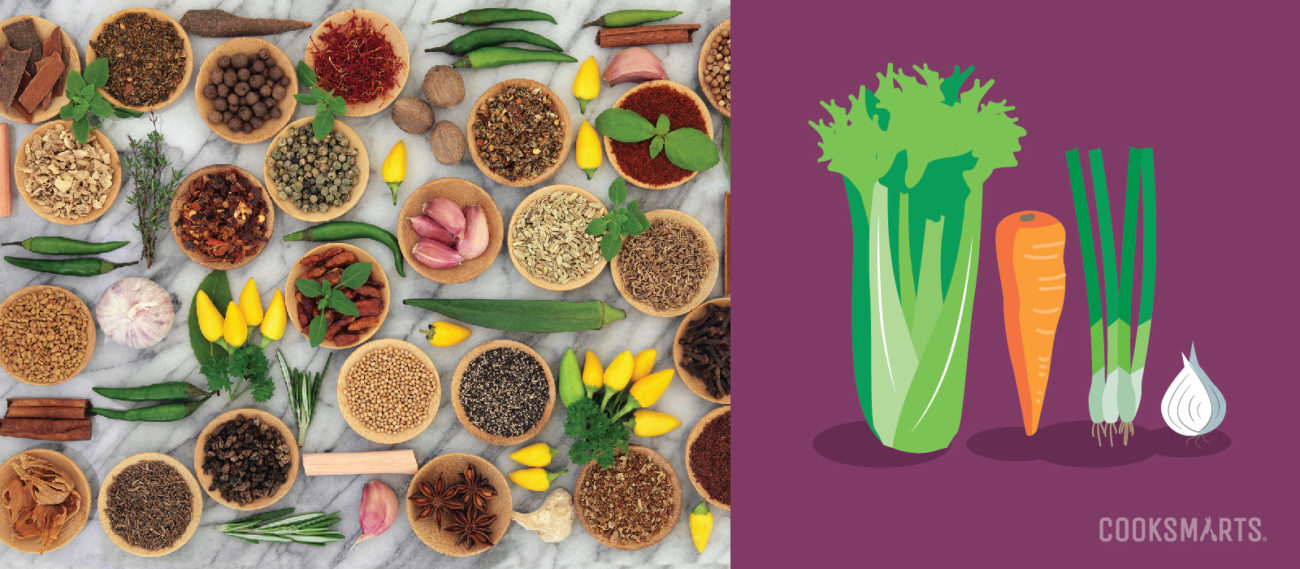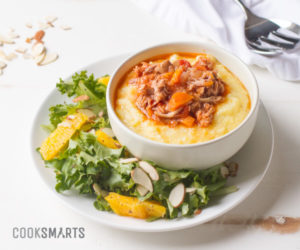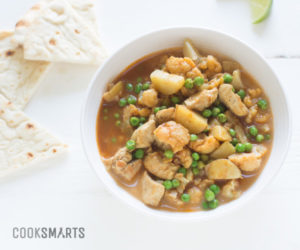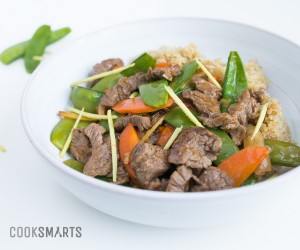Guide to Adding Flavor with Aromatics
Add flavor, aroma, and depth to your dishes by learning about aromatics – the foundation that builds the personality of a dish and takes it from good to great.
This is part 6 of our ‘How to Maximize Flavor’ series. Read more about it here and see how you can become a flavoring pro and never cook a bland meal again!
If you’ve been cooking for some time, you’ve probably noticed that most recipes – whether it’s a sauce, soup, or saute – starts with some combination of garlic, onions, ginger, celery, or carrots.
These are some of the most common aromatics in the food world and are used across many types of ethnic cuisines. However, this category of ‘aromatics’ is definitely not limited to these Big 5.
There are many other vegetables and herbs that are used as aromatics and we’ll explore many of them in this post. Here’s what we’ll cover:
- The culinary definition and use of aromatics
- How to prepare aromatics
- When to use aromatics
- Aromatics by ethnic cuisines – with infographic!

Culinary Definition & Use of Aromatics
Aromatics are combinations of vegetables and herbs (and sometimes even meats) that are heated in some fat – like butter, oil, or coconut milk – at the beginning of a dish. The heated fat helps these ingredients release addictive aromas and impart deep flavors into the dish that’s being cooked.
Sauces, braises, curries, rice dishes, sautes, stir-fries, soups, stews, and stocks all typically start off with aromatics, which help form the flavor foundation of these dishes.
Try making a soup without onions. You’ll notice that it just doesn’t taste as sweet.
Or cook a curry without garlic and ginger. It’ll feel a bit empty.
In sum, aromatics give dishes flavor and a foundation to build their personality. Tweet this tip
How to Prepare Aromatics
For the most part, there are two simple rules for how to prep or chop aromatics:
- If you plan on fishing the aromatics out of the final dish, like in a stock, don’t worry too much about chopping. Halve the onion or chop a carrot into 3 or 4 pieces, but there’s no need to worry about fine knife work. You can even throw a whole sprig of thyme in – the leaves will come off and you can easily remove the stem before serving.
- If the aromatics will be a part of the final dish, then you’ll want to finely dice or chop them. The extra surface area means it’ll release more flavor in a shorter time, plus the smaller size means it’ll melt into the textures of the final production.
Below we have videos that show you how to prep some of our most commonly used aromatics:
How to Chop & Dice an Onion
Learning how to dice an onion correctly will save you so much time in the kitchen.
How to Chop Carrots
Watch this video to learn our tips on how to best peel, chop, and dice carrots easily.
How to Dice Celery
Learn how to chop celery for use in stir-fries, soups, sautes, and salads.
How to Peel, Grate and Chop Ginger
See how easily we peel ginger and then grate it or chop it.
When to Use Aromatics
Aromatics can be used in so many dishes. Here is a list that would benefit from the depth aromatics bring:
- Sauces – common in French, Italian, and Latin cooking
- Braises – common in French, Latin, and Middle Eastern cooking
- Curries – common in Indian and Thai cooking
- Vegetable sautes – common across all cuisines
- Stir-fries – common in Chinese cooking
- Soups, stews, and stocks – common across all cuisines
Try one of these dishes to experience the effect of aromatics on different ethnic cuisines:



Aromatics by Ethnic Cuisines
The infographic below illustrates our 8 most popular aromatic combinations by ethnic cuisine. We’ve also provided you with the name of that aromatic combination if one exists and other supplemental ingredients you can layer on top of that combo to make it have even more flavor personality.
So, if you’re making a French-inspired dish, you’ll want to use a mirepoix (pronounced meer – a – pwah). Start off with some heated butter or olive oil and then toss in your diced onions, carrots, and celery. Typically the ratio is 2 parts onions to 1 part carrots and 1 part celery but feel free to make your own rules – that’s the fun part of cooking! You can also add in some parsley, thyme, bay leaves, or Herbs de Provence. Add some salt and pepper and just let the heat bring out the flavors of your aromatics for a few minutes before adding the other ingredients in your dish.
Similarly for a Chinese stir-fry, you’ll want to heat some cooking oil in a wok and then add in your aromatic combo of garlic, green onions, and ginger. If you’re feeling spicy, add in some chopped chilies.
Take a deep breath and enjoy the aromas before adding the other stir-fry ingredients.
Guide to Aromatics
Create delicious flavor foundations for a variety of meals.
Add Depth & Flavor to Your Meals
Create delicious flavor foundations with our Guide to Aromatics.
I acknowledge by requesting this info, I'll be added to Cook Smarts' newsletter list. I can unsubscribe at any time.
Some More Cooking with Aromatics Tips
Lastly, we believe there are very few rules in cooking. Feel free to:
- Create ethnic fusions! Who knows what a little ginger can do to a French dish? You won’t know until you try. If you love ginger, it might be delightful.
- Just use part of the aromatic combo in your dish. Traditions are meant to be broken so if you don’t have all the ingredients for a traditional soffritto, you can still start your Italian meal off with the aromatics you do have on hand.
- Not get too stuck on ratios or measurements. If you love garlic, use more garlic. If you love onions, use more onions. Your dish will be completely okay (and probably great!).
We hope this lesson on aromatics helps you create meals with great flavor. As always, we work incredibly hard to create this cooking info, so please do help us spread the smarts!
- Week 1: Our 3 Simplest Flavoring Secrets
- Week 2: Spice Up Your Cooking with Our Spice Charts
- Week 3: A Study of Flavor Profiles
- Week 4: 5 Sauces You Can Use on Everything
- Week 5: Keep it Fresh with Herbs
- Week 6: Using Aromatics to Add Depth (that’s this week!)
- Week 7: Surprise Giveaway!
